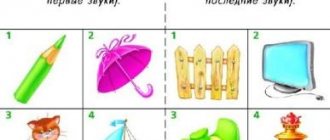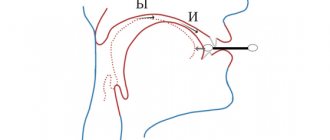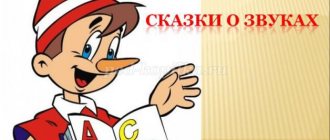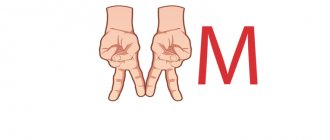Lesson 1
Program content. Introducing children to the term “word”. Expanding ideas about the diversity of words. Development of voluntary movements of the fingers.
Material. Characters from the fairy tale “Kolobok”, basket, prize chips.
Progress of the lesson
Work based on the fairy tale "Kolobok". The teacher invites the children to remember the fairy tale “Kolobok” and name its characters. The child names the hero of the fairy tale, for example a bear, and takes it. The teacher says: “Sasha, you will be a bear.” Similar work is carried out with the rest of the characters in the fairy tale. At the same time, the teacher emphasizes that each character is called a certain word.
Reading the poem “Plim” by I. Tokmakova. The teacher reads a poem.
Didactic game "Children's World". Children name words denoting toys that can be bought at Children's World. For correct answers, the kids receive chips, which they then put into a common basket. The teacher praises the children for how many different words they named.
Game “Who did you meet in the forest?” The teacher suggests remembering the “magical forest and fairy-tale meadow” where they once met a deer and a bunny. Children pretend to be animals (see lesson 8, younger group).
The teacher draws the children’s attention to the expressiveness of the movements: the deer walks proudly and importantly, raising its legs high; the bunny's ears are tense or folded when he cowardly hides, etc.
Lesson 2
Program content. Introducing children to sound words. Development of voluntary movements of the fingers.
Material. Subject pictures depicting animals, birds, fish, a basket, prize chips, a mirror.
Progress of the lesson
Didactic game "Zoo". Children name the animals that live in the zoo. For the correct answer, kids receive chips. For children who cannot cope with the task, the teacher offers pictures of familiar animals that they must name. During the game, the teacher each time focuses the children’s attention on the term “word”: “Tanya said the word ‘hippopotamus’, and Vova said the word ‘parrot’...”
At the end of the game, all the chips are placed in a basket.
Reading the poem by A. Barto “Word Game”.
The teacher generalizes: “Any word can be said both quietly and loudly.”
Game “Who did you meet in the forest?” The teacher invites the children to “go for a walk in the forest.” In the forest they meet a hare. The teacher says: “These are bunny ears” (shows the index and middle fingers raised up, the remaining fingers clenched). The bunny jumps along the path: jump-jump, ears clap-clap.” (Imitates this movement with his fingers.) The guys repeat the movement several times.
The children go further and meet a deer. Children raise their arms above their heads, palms open, fingers tense. If this movement does not work, the teacher invites the children to look in the mirror, at each other, and compare who has the better horns. You can also ask children to imitate the gait of a deer. The deer walks importantly, raising its legs high, proudly turning its head in different directions.
The guys go out into the clearing and meet a turtle. When portraying a turtle, each child clenches his fingers into a fist and moves his thumb to the side. The children hide their fingers, then show them again. (You can depict a snake in the same way: put your thumb out from under your clenched fist and move it like the head of a snake.)
Lesson 3
Program content. Expanding ideas about the meaning of words. Comparing words by sound. Developing the ability to select matching words for a given word. Development of voluntary movements of the fingers.
Material. Basket, prize chips, ball.
Progress of the lesson
Reading of A. Shibaev’s poem “A name is given to everything...”.
Didactic game "Shop". Children name the objects and toys they want to buy. For each correct answer they receive prize chips. Then they put them in a basket.
“That's how many words you named! - says the teacher. “They all sound different, but some sound similar.”
Game "Name the Pair". Children form a circle. The teacher stands in the center of the circle, says a word and throws the ball to one of the children. The child names a word that sounds similar and returns the ball back. For example: jackdaw - stick, bear - cone, river - stove, stove - candle, floor - table, crayfish - poppy, Masha the Confused, etc.
In this game, you can use a “magic wand” instead of a ball.
Game “Who did you meet in the forest?” The teacher asks the children to remember the turtle (see lesson 2, middle group) and draw it with their hands. If there is sun, you can show the children a shadow theater.
Lesson 4
Program content. Expanding your understanding of words. Getting to know the length of words. Development of voluntary movements of the fingers.
Material. Study guide “Sound clock” (from the book by A. I. Maksakov and G. A. Tumakova “Teach by playing.” - M.: MOSAIKA-SYNTHESIS, 2005) or object pictures (clock, bow, cows, geese, ball, car , airplane, crayfish, fish, house, steamship, etc.), arrow; small toys, chips, basket.
Progress of the lesson
Reading the poem by G. Satyr “Li-mon”.
Measuring the length of words. The teacher notices that there are long and short words, that each of them can be measured in claps or steps. (The term “syllable” is not used.)
The teacher invites the children to measure the words: elephant, frog, mother, doll, bag, cherry, road, car, steamship, etc. Children measure the number of syllables in words by clapping or walking them. You can place small toys or chips in accordance with the number of syllables in a word (sequentially in the process of clapping or walking).
Working with the “Sound Clock” manual (Fig. 9). The teacher invites the children to look at the pictures, name first short, then long words and measure them with claps or steps.
By working with the Sound Clock and moving the hands, children determine the length of words.
Didactic game “Name the tasty words.” Children fill a basket of “tasty things”, putting into it chips that the teacher gives for each correctly named word.
Game "Apple Tree". The children stand in a circle and the teacher reads the poem while performing the appropriate movements. Children repeat the actions after the teacher.
The game is repeated several times.
Rice. 9
Lesson 5
Program content. Teaching children how to distinguish sounds in words. Introduction to the term "sound". Consolidating knowledge about the length of words. Development of voluntary movements of the fingers.
Material. Flannelgraph, object pictures depicting a beetle, giraffe, ice cream, knife, acorn, etc. (7–9 pieces, the names of 5–6 of them have the sound zh), small toys or chips, mirror.
Progress of the lesson
Reading a poem by G. Vieru:
Game "The Bugs Have Arrived". “Beetles flew to us from the forest. Hear how they buzz: “Zh-zh-zh-zh,” says the teacher and shows with his hand how the beetles fly (children repeat the movements and onomatopoeia). - They were tired and sat down to rest on a leaf (palm). We rested and flew into the forest again (imitates the flight of a beetle, pronouncing the sound z at first loudly, then quieter and quieter). The beetles flew away, but left us their song. Which one? (Zh-zh-zh.) The teacher suggests pronouncing the word beetles, emphasizing the sound zh intonationally. (The sound z is pronounced without the vowel sound.)
Game "Find the picture." The teacher displays pictures on a flannelgraph. Children take turns finding pictures whose names contain the sound zh, name the words and intonationally highlight the sound zh.
Game "Telegraph". The teacher explains to the children the rules of the telegraph and offers to send a telegram. The teacher names several one-, two- and three-syllable words, and the children “transmit them by telegraph” (clap them, tap out the number of syllables in them). To prevent children from getting lost, you can lay out small toys or chips in accordance with the number of syllables in a word.
Game "Apple Tree". The teacher, together with the children, repeats the poem about the apple tree (see lesson 4, middle group). At the same time, children carefully look at each other or in the mirror.
Lesson 6
Program content. Teaching children how to distinguish sounds in words. Development of the ability to select words with a given sound. Development of voluntary movements of the fingers.
Material. Fan, prize chips, basket.
Progress of the lesson
Reading a poem. The teacher reads the poem, highlighting the sound w:
The teacher asks the children which sound was repeated most often in the poem. Children pronounce words with the sound sh, emphasizing it intonationally: frog, jump, top, fly.
Game "Wind-breeze". The teacher asks the children what song the wind sings. (Sh-sh-ui.) When the teacher says: “A strong wind is blowing,” the children pronounce the sound ui loudly; and when he says: “A weak wind is blowing,” the guys pronounce the sound ui quietly.
Game “Name the words with the sound w.” Children name words, for example: bear, cat, baby, noise, cone, etc. For each correct answer they receive chips, which they put in a basket at the end of the game. (The correct answer is also considered to be the pronunciation of the words nosh-ka, loshka, esh, nosh, etc.).
Game "Fan". The teacher shows the children a fan, tells them what it is for, and demonstrates how to use it. Then he invites the children to quickly connect the straightened, tense fingers on both hands (starting with the little finger) - they will get a fan.
Lesson 7
Program content. Teaching children how to distinguish sounds in words. Comparing words by sound. Development of the ability to select words with a given sound. Development of finger movements.
Material. Flannelograph, subject pictures depicting a fox, a hare, a magpie, a fly, a wolf; basket, prize chips.
Progress of the lesson
Reading a tongue twister. The teacher says a tongue twister:
Children determine which sound is repeated most often in a tongue twister, name it and pronounce the tongue twister 3-4 times, emphasizing the sound sch intonationally.
Game “Name the words with the sound u”. Children name words, for example: cabbage soup, sorrel, tongs, pike, grove, goldfinch, etc. For each correct answer they receive chips, which at the end of the game they put in a basket
Game "Words-friends". The teacher displays pictures of a fox, a hare, a magpie, a fly, and a wolf on a flannelgraph. Children look at the pictures and name them. The teacher offers to find characters from familiar fairy tales and choose friend words for their names: white-sided magpie, little fox-sister, clattering fly, runaway bunny, wolf-click with teeth, etc.
Game "Butterflies". The teacher invites the children to turn into butterflies and fly to a “fairy meadow.” Children raise their arms above their heads, press their hands together with their outer sides and move their fingers freely, like wings.
Lesson 8
Program content. Teaching children how to distinguish sounds in words. Development of the ability to select words with a given sound. Development of voluntary movements of the fingers.
Material. Prize chips, basket.
Progress of the lesson
Reading a poem.
Children determine which sound is repeated most often in the poem, name it and read the poem, emphasizing the sound ts intonationally. Then they name words with the sound ts.
Game “Name the words with the sound t.” Children name words, for example: heron, circus, princess, bird, hoof, tsok-tsok, etc. For each correct answer they receive chips, which they then put in a basket.
Game "Guess the riddle." The teacher invites children to use familiar movements, characteristic sounds, intonations, and gestures to portray some animal or fairy-tale character. Children take turns asking riddles, and the rest of the children guess them.
By organizing this game, you can build a stage, an auditorium, and distribute tickets to children.
Lesson 9
Program content. Teaching children how to distinguish sounds in words. Improving the ability to select words with a given sound. Development of voluntary movements of the fingers.
Material. Prize chips, basket.
Progress of the lesson
Reading a poem. The teacher reads the poem, highlighting the sound h.
Children determine which sound is repeated most often in the poem, name it and read the poem, emphasizing the sound h. Then they name words with the sound h.
Game “Name the words with the sound h.” For example: teapot, stuffed animal, cups, black, worm, night, swing, brown, etc.
Game "Beehive". Children hold their hands in front of them and clench their fingers into fists, depicting a beehive. Then they “release the bees one at a time,” bending their fingers, starting with the little finger. At the same time, children depict how bees buzz. Then the guys bend their fingers one at a time, starting with the thumb (“the bees are gathering in hive houses”). The exercise is performed on both hands.
Lesson 10
Program content. Teaching children how to distinguish sounds in words. Development of ideas about hard and soft consonant sounds. Development of the ability to select words for a given sound.
Material. Prize chips, basket.
Progress of the lesson
Game "Big and small balls". The teacher invites the children to “pump up” a large ball with a large pump. Children imitate the teacher and “pump up” a large ball, saying: “Ssss.” Then the teacher says that there is still a small ball, and it needs to be “pumped up” with a small pump (ss-s-s). The game is repeated several times. When the teacher says: “Big ball,” the children say: “Ssss,” and when he says: “Small ball,” the children say: “Sssssss.”
The teacher draws the children's attention to the fact that the sounds s and s are similar, but there is also a difference between them. “The sound s sounds firm, this is “big brother,” and the sound s is pronounced gently, softly, this is “little brother.” The following figures can be used as real images of older and younger brothers:
Blue color
Green color
Reading a poem. The teacher reads a poem, emphasizing the sounds si intonation.
The mouse sat in the corner,
Ate a piece of bagel.
G. Vieru Game “Name words with sounds s and s.” Children name the words (juice, forty, seven, himself, beads, nose, elk, Lucy, earrings, pine, etc.), and the teacher arranges the chips into two groups: puts the chip to the “big pump” (picture with the image of “big brother” "), when the guys say a word with the sound s, and to “little pump” (a picture with the image of a “little brother”) - when they pronounce a word with the sound sj. Then the chips are put into the basket Game "Beehive". See lesson 9, middle group. Lesson 11 Program content. Teaching children how to distinguish sounds in words. Distinguishing between hard and soft consonants. Improving the ability to select words with a given sound. Development of voluntary movements of the fingers. Material. Flannelgraph, subject pictures, the names of which contain the sounds з and зъ, and pictures, the names of which do not have these sounds; pictures of large and small mosquitoes, prize chips, and a basket. Progress of the lesson “Walk in the forest”. The teacher and the children “go” to the forest for a walk to listen to what sounds live in it (the wind is noisy, a brook is babbling, birds are singing, animals are growling, beetles are buzzing, etc.). Reading an excerpt from K. Chukovsky’s poem “The Tsokotukha Fly.”
Suddenly it flies from somewhere
Little mosquito
And his hand is burning
Small flashlight.
The teacher asks the children: “What song does the mosquito sing? (Z-z-z.) How does a big mosquito sing? (Z-z-z.) And how does the little mosquito sing?” (Zz-z-z.) The teacher draws the children’s attention to the fact that the sounds of ziz are similar, but there is also a difference between them: “The little mosquito sings its song gently, softly: “Zz-z-z,” and the big mosquito sings it harshly. , firmly: “Z-z-z.” The teacher invites the children to sing the song of the big and small mosquitoes. Game “Arrange the pictures.” “Each child has 2-3 pictures whose names contain the sounds z and z, and one picture whose name does not have these sounds. On the flannelgraph there are images of large and small mosquitoes (conventional images are possible). The teacher invites the children to divide the pictures into two groups: cards with the sound z in their names should be placed next to the large mosquito, cards with the sound z in the name should be placed next to the small mosquito. The teacher together with the children checks the correctness of the task. Game “Name the words with the sounds z and z.” The children name the words, and the teacher puts the chips into two groups: puts a chip next to the big mosquito when the children say a word with the sound з, and next to the small mosquito - when they pronounce the word with the sound зъ. Then the chips are put into a basket. Lesson 12 Program content. Teaching children how to distinguish sounds in words. Distinguishing between hard and soft consonants. Improving the ability to select words with a given sound. Development of voluntary movements of the fingers. Material. Large and small baskets (boxes, bags, etc.), prize chips. Course of the lesson Reading an excerpt from the poem “A Stream” by L. Kvitko (translation by E. Blaginina). The teacher reads the poem, emphasizing the sound intonation:
Goat with hoofs -
Knock-knock!
It would be nice to get drunk:
Jump (K) – jump (K).
Children identify the sound that is repeated most often in the poem (sound k), name words with this sound. The teacher explains that the sound k sounds firm - this is “big brother.” Then he asks to name his “little brother,” which sounds soft. (Sound k.) Game “Shop”. Children “buy” products (chips) with the sound k and put them in a large basket (sausage, milk, candy, chocolate, flounder, etc.) and products with the sound k, which are put in a small basket (kefir, sausages, sprat, cake , sausages, etc.). Exercise "Waves". The guys place their hands intertwined in their hands at chest level and move them rhythmically. To create a rhythm, you can read an excerpt from S. Marshak’s poem “The Ship”:
The boat is sailing, sailing,
The ship is golden.
Lucky, lucky gifts,
Gifts for you and me.
Lesson 13 Program content. Teaching children how to distinguish sounds in words. Development of the ability to determine the first sound in a word. Distinguishing between hard and soft consonants. Improving the ability to select words with a given sound. Mastering the action of syllabic division of words. Development of voluntary movements of the fingers. Material. Toys and objects (according to the number of children), prize chips, ball. Progress of the lesson Game “Name the first sound”. The teacher invites 4-5 children to stand in a row at the board. Then he asks which of the guys is standing first. The teacher explains to the children that words also have a first sound, for example, in the word shishka the first sound is w, in the word poppy there is the sound m, in the word forest there is the sound l. The teacher gives the children toys and objects (doll, car, bear, hare, ball, cup, spoon, ball, etc.) and asks them to identify the first sounds in their names. Game “Name the Pair.” Children stand in a circle. The teacher calls a hard consonant sound (soft sound) and throws a ball to the child, who in response calls a soft sound (hard sound) and returns the ball. Instead of a ball, you can use a magic wand, with which the teacher touches the child. Game "Telegraph". Children name words consisting of one, two and three syllables and measure their length. Exercise "Waves". See lesson 12, middle group.




